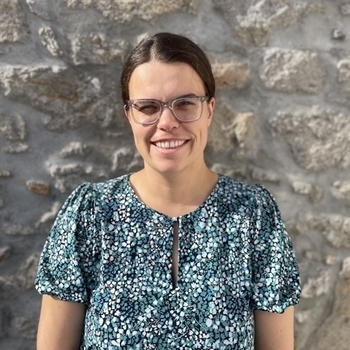
U-M BME PhD Student Mariana Masteling Receives Two Honors at Recent ASB Conference
Student honored for her doctoral research

Student honored for her doctoral research
Congratulations to U-M BME PhD recent graduate Mariana Masteling for recently receiving two awards at the American Society of Biomechanics (ASB) conference in Knoxville, Tennessee.
Masteling won the Clinical Biomechanics Award for “Two minutes is sufficient to characterize the viscoelastic properties of the lower human birth canal during the first stage of labor.” Her collaborators were John O.L. DeLancey, the Norman F. Miller Professor of Gynecology at the University of Michigan Medical School and the Director of Pelvic Floor Research in the Department of Obstetrics and Gynecology; and BME’s James A. Ashton-Miller, Associate Chair for Translational Research, Albert Schultz Collegiate Research Professor and Distinguished Research Scientist, Biomedical Engineering, Research Professor, Biomedical Engineering, Research Professor, Mechanical Engineering, Research Professor, Internal Medicine, and Research Professor, Institute of Gerontology, who are the founders of the U-M Pelvic Floor Research Group, the first such group in the world established to identify risk factors for developing pelvic floor disorders, work with high-risk women to prevent them, and provide the most effective and newest treatments for pelvic floor dysfunction. The group hosts a Pelvic Floor Research Day early each year, attracting approximately 70 global participants. Masteling also won first place in the Three Minute Thesis Graduate Competition at the ASB conference.
Dr. Ashton-Miller described Masteling’s research as “significant” because no one currently measures the viscoelastic properties of the lower birth canal in living women. “The lower birth canal is the main impediment to vaginal delivery because, as we have earlier shown, its tissues have to stretch over three-times their original length,” Dr. Ashton-Miller said. “Too stiff and/or too viscous, and vaginal delivery of the fetus is impossible, so both fetus and mother can die without a c-section; a little less stiff, and the second stage of labor will be too long, thereby placing fetus and/or mother at risk for injury. So if one can measure how ‘stretchy’ the tissue is before the second stage begins, the clinician and mother can decide either that there is no cause for concern (which happily is the case for ~80% of women) or, if it is too stiff, they can discuss interventions to help deliver the baby.”
Dr. Ashton-Miller added that, in one chapter of her dissertation, Masteling provides the first-ever data that establish the normal distribution, and importantly the mean + 3* standard deviation of lower birth canal stiffness and viscosity values, providing the foundation to establish the first lower-birth-canal screening test for unusually stiff or viscous birth canal tissue. “This will open the way for physicians and midwives to identify those at risk and also new medical interventions to ripen its tissues in an analogous manner to those that can help ripen the cervix,” Dr. Ashton-Miller said. “In addition, it facilitates new research into the mechanobiology of the birth canal ripening process. Other chapters employ theoretical models to help provide the means to predict who is at risk for unduly long labors and/or injury.”
Masteling contacted Dr. Ashton-Miller in 2014 from the University of Porto in Portugal, asking to conduct research for her Master’s degree in his Biomechanics Research Laboratory at U-M. “ I accepted her because she was the first woman in 150 years to play the euphonium in her local band, had switched from studying medicine to engineering, and was a strong candidate for a Fulbright Award to support herself while studying with me,” he said.
“Despite the challenges of the Covid pandemic, Mariana persisted and, among others, worked with scientists from the University of Cambridge in implementing her theoretical models of lower birth canal viscoelastic properties,” Dr. Ashton-Miller said. “Meanwhile, she has consistently provided technical support to U-M Obstetrics and Gynecology for MRI and ultrasound image analysis, as well as the U-M School of Nursing in developing a physical model to teach midwives about cervical ripening. During her doctorate she also provided technical and other mentorship to ten undergraduate and graduate students, several Ob-Gyn medical residents and fellows, routinely shared her algorithms on Github for others to use, all the while being active in community service outside the university.”
“For much of her doctorate in biomedical engineering at U-M, Mariana was supported by National Institutes of Health (NIH) Small Business Innovation Research (SBIR) Fastrac funds, which we had suggested a Stanford startup company, Materna Medical, LLC, should apply for given they wanted to collaborate,” Dr. Ashton-Miller added. “The company went on to raise significant venture capital support to run the ongoing EASE clinical trial for its PREP vaginal dilation device at 15 medical centers around the United States. Throughout we have enjoyed a close and productive collaboration with Materna. Part of Mariana’s dissertation involved analyzing the biomechanics data gathered by the PREP device during the first stage of labor. She presented the results from the first 56 women at the 2023 national meeting of maternal fetal medicine specialists in San Francisco early this year. The EASE trial is scheduled to conclude later this year after enrolling 200 women.“
Dr. Ashton-Miller concluded: “Mariana’s dissertation is some of the most important doctoral research to come out of my laboratory since I joined U-M in 1983. She is bringing uncommon recognition to the University of Michigan in her field and represents the very best of our graduate students.”